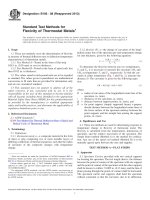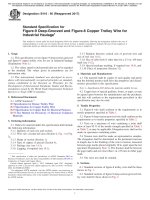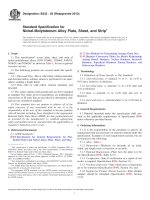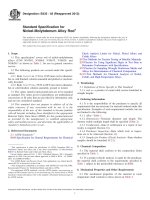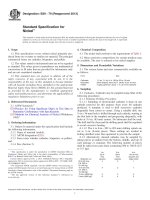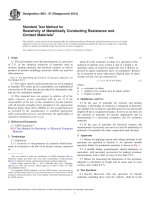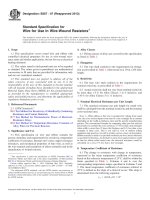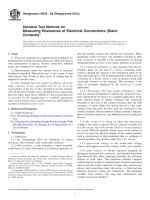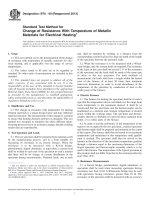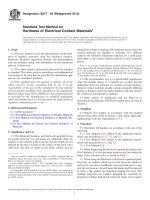Astm b 866 95 (2013)
Bạn đang xem bản rút gọn của tài liệu. Xem và tải ngay bản đầy đủ của tài liệu tại đây (93.48 KB, 4 trang )
Designation: B866 − 95 (Reapproved 2013)
Standard Test Method for
Gross Defects and Mechanical Damage in Metallic Coatings
by Polysulfide Immersion1
This standard is issued under the fixed designation B866; the number immediately following the designation indicates the year of
original adoption or, in the case of revision, the year of last revision. A number in parentheses indicates the year of last reapproval. A
superscript epsilon (´) indicates an editorial change since the last revision or reapproval.
1. Scope
B246 Specification for Tinned Hard-Drawn and MediumHard-Drawn Copper Wire for Electrical Purposes
B374 Terminology Relating to Electroplating
B488 Specification for Electrodeposited Coatings of Gold
for Engineering Uses
B542 Terminology Relating to Electrical Contacts and Their
Use
B545 Specification for Electrodeposited Coatings of Tin
B605 Specification for Electrodeposited Coatings of TinNickel Alloy
B679 Specification for Electrodeposited Coatings of Palladium for Engineering Use
B689 Specification for Electroplated Engineering Nickel
Coatings
B733 Specification for Autocatalytic (Electroless) NickelPhosphorus Coatings on Metal
B735 Test Method for Porosity in Gold Coatings on Metal
Substrates by Nitric Acid Vapor
B741 Test Method for Porosity In Gold Coatings On Metal
Substrates By Paper Electrography (Withdrawn 2005)5
B765 Guide for Selection of Porosity and Gross Defect Tests
for Electrodeposits and Related Metallic Coatings
B798 Test Method for Porosity in Gold or Palladium Coatings on Metal Substrates by Gel-Bulk Electrography
B799 Test Method for Porosity in Gold and Palladium
Coatings by Sulfurous Acid/Sulfur-Dioxide Vapor
B809 Test Method for Porosity in Metallic Coatings by
Humid Sulfur Vapor (“Flowers-of-Sulfur”)
1.1 This test method covers equipment and methods for
detecting gross defects and mechanical damage (including
wear-through) in metallic coatings where the breaks in the
coating penetrate down to a copper or copper alloy substrate.
1.2 This test method is suitable for coatings consisting of
single or combined layers of any coating that does not
significantly tarnish in an alkaline polysulfide solution. Examples are gold, nickel, tin, tin-lead, and palladium, or their
alloys.
1.3 Recent reviews of porosity testing (which include those
for gross defects) and testing methods can be found in
literature.2,3 An ASTM guide to the selection of porosity and
gross defect tests for electrodeposits and related metallic
coatings is available as Guide B765. Other related porosity test
standards are Test Methods B735, B741, B798, B799, and
B809.
1.4 The values stated in SI units are to be regarded as the
standard. The values given in parentheses are for information
only.
1.5 This standard does not purport to address all of the
safety concerns, if any, associated with its use. It is the
responsibility of the user of this standard to establish appropriate safety and health practices and determine the applicability of regulatory limitations prior to use.
2. Referenced Documents
2.1 ASTM Standards:4
3. Terminology
3.1 Definitions: Many terms used in this test method are
defined in Terminologies B374 or B542.
1
This test method is under the jurisdiction of ASTM Committee B08 on Metallic
and Inorganic Coatings and is the direct responsibility of Subcommittee B08.10 on
Test Methods.
Current edition approved Dec. 1, 2013. Published December 2013. Originally
approved in 1995. Last previous edition approved in 2008 as B866 – 95(2008). DOI:
10.1520/B0866-95R13.
2
Clarke, M., “Porosity and Porosity Tests,” in Properties of Electrodeposits,
edited by Sard, Leidheiser, and Ogburn, The Electrochemical Society, 1975, p. 122.
3
Krumbein, S. J., “Porosity Testing of Contact Platings,” Trans. Connectors and
Interconnection Technology Symposium, Philadelphia, PA, October 1987, p. 47.
4
For referenced ASTM standards, visit the ASTM website, www.astm.org, or
contact ASTM Customer Service at For Annual Book of ASTM
Standards volume information, refer to the standard’s Document Summary page on
the ASTM website.
3.2 Definitions of Terms Specific to This Standard:
3.2.1 defect indications—black or dark colored products
resulting from the reaction between the alkaline polysulfide
reagent and exposed copper or copper alloy underlying metal.
3.2.2 gross defects—breaks in the coating that expose relatively large areas of underlying metal to the environment
(compare with intrinsic porosity (3.2.3)). Gross defects include
5
The last approved version of this historical standard is referenced on
www.astm.org.
Copyright © ASTM International, 100 Barr Harbor Drive, PO Box C700, West Conshohocken, PA 19428-2959. United States
1
B866 − 95 (2013)
5.3 The alkaline polysulfide test has been specified in
several ASTM specifications for tin-plated coatings, namely
Specifications B246 and B545. This test could also be used to
detect gross defects and mechanical damage in other metallic
coatings, such as tin-nickel alloy (Specification B605), nickel
(Specification B689), gold (Specification B488), palladium
(Specification B679), and autocatalytic nickel-phosphorous
coatings (Specification B733).
those produced by mechanical damage and wear, in addition to
as-plated large pores (with diameters an order of magnitude
greater than intrinsic porosity) and networks of microcracks.
NOTE 1—Such large pores and microcrack networks indicate serious
deviations from acceptable coating practice (as, for example, dirty
basis-metal substrates and contaminated or out-of-balance plating baths).
3.2.3 intrinsic porosity—the “normal” porosity that is
present, to some degree, in all commercial thin platings (such
as in precious-metal coatings for engineering purposes) and
will generally follow an inverse relationship with thickness.
5.4 This test detects mechanical damage that exposes copper underplate and copper basis metal. Such damage may occur
in any post-plating operation or even towards the end of the
plating operation. It is most often seen to occur in product
assembly operations.
NOTE 2—Intrinsic porosity is due primarily to small deviations from
ideal plating and surface preparation conditions. Scanning electron microscope (SEM) studies have shown that the diameter of such pores, at the
plating surface, is of the order of micrometres, so that only small areas of
underlying metal are exposed to the environment.
5.5 If properly performed, this test will also detect wearthrough, provided the wear-through reaches a copper or
copper-alloy layer.
3.2.4 measurement area—the portion or portions of the
surface examined for the presence of gross defects or mechanical damage (and wear-through). The measurement area shall be
indicated on the drawings of the parts, or by the provision of
suitably marked samples.
3.2.5 metallic coatings—platings, claddings, or other metallic coatings applied to the basis-metal substrate. The coating
can comprise a single metallic layer or a combination of
metallic layers.
3.2.6 porosity (general)—in a coating, the presence of any
hole, crack, or other defect that exposes the underlying metal to
the environment.
3.2.7 underplate—a metallic coating layer between the basis
metal and the topmost metallic coating. The thickness of an
underplating is usually greater than 1 µm, in contrast to a strike
or flash, which is usually thinner.
3.2.8 wear-through—the exposure of underplate or basis
metal as a direct result of wear. Wear-through is an observable
phenomenon.
3.2.9 wear track—a mark that indicates the path along
which physical contact had been made during a sliding process
(such as the mating and unmating of an electrical contact).
5.6 Many types of gross defects are too small to be seen,
except at magnifications so high (as in SEM) that a realistic
assessment of the measurement area cannot be easily made.
Other defects, such as many types of wear-through, provide
insufficient contrast with the coating surface. Gross defects
tests (as with porosity tests) are, therefore, used to magnify the
defect sites by producing visible reaction products in and
around the defects.
5.7 The polysulfide solution will react with copper and
copper alloys to produce a dark brown or black stain (the defect
indications) at the site of the defect. Silver also turns black
under the same conditions. The test solution will not react with
nickel and is only useful when the presence or absence of
copper exposure is a specific requirement.
5.8 The polysulfide immersion test is relatively insensitive
to the presence of small pores. It shall not be used as a general
porosity test. (Test Method B809 should be used instead.)
5.9 The extent and location of the gross defects or mechanical damage (revealed by this test) may or may not be
detrimental to product performance or service life. Such
determinations shall be made by the user of the test through
practical experience or judgment.
4. Summary of Test Method
4.1 The test samples are immersed in an alkaline polysulfide
solution at 74°C (165°F) for 60 s. After rinsing and drying, the
samples are examined for dark or discolored areas which
indicate exposure of copper or copper alloys to the solution
through breaks in the coating.
5.10 The present test can be used on samples of various
geometries, such as curved surfaces. It can also be used for
selective area coating if allowance is made for tarnish creepage
from bare copper alloy areas.
5.11 This test is destructive in that it reveals the presence of
gross defects by contaminating the surface with reactionproduct films. Any parts exposed to this test shall not be placed
in service.
5. Significance and Use
5.1 The purpose of the alkaline polysulfide immersion test is
to determine the presence of mechanical damage, wearthrough, and other gross defects in the coating. Most metallic
coatings are intended to be protective and the presence of gross
defects indicates a serious reduction of such protection.
5.12 However, the defect indications on the sample surfaces
that result from this test are stable; samples may be retained for
reference purposes.
5.2 The protection afforded by well applied coatings may be
diminished by improper handling following plating or as a
result of wear or mechanical damage during testing or while in
service. The alkaline polysulfide test serves to indicate if the
damage has extended down to the copper or copper alloy basis
metal since it will not detect exposed nickel underplate.
5.13 This test is neither recommended for predictions of
product performance nor is it intended to simulate field failure
mechanisms. For such product performance evaluations, an
environmental test that is known to simulate actual failure
mechanisms should be used.
2
B866 − 95 (2013)
9.1.1.8 Store solution in a tightly capped 250-mL plastic
bottle labeled, “Polysulfide Solution, sp gr 1.142,” and date it.
9.1.2 Alkaline Polysulfide Reagent:
9.1.2.1 Measure 75 mL of the polysulfide solution, sp gr
1.142 into a 600-mL beaker containing a teflon-coated stirring
bar.
9.1.2.2 Weigh out 75 g of sodium hydroxide pellets into a
plastic weighing dish.
9.1.2.3 Add the sodium hydroxide carefully to the polysulfide solution. Cover beaker. Stir to dissolve.
9.1.2.4 Add 375 mL of deionized water to the beaker, cover,
and stir to mix.
9.1.2.5 Store solution in a tightly stoppered 500-mL plastic
bottle labeled, “Alkaline Polysulfide Reagent,” and date it.
6. Apparatus
6.1 In addition to the normal equipment (beakers, bottles,
weighing balances, funnels, and so forth) that are part of every
chemical laboratory, the following apparatus are required:
6.1.1 Microscope—Optical, stereo, 10 to 30×. It is preferred
that one eyepiece contain a graduated reticle for measuring the
diameter of tarnish spots. The reticle shall be calibrated for the
magnification at which the microscope is to be used, preferably
10×.
6.1.2 Hydrometer, 1.120 to 1.190 specific gravity, 150–mm
scale.
6.1.3 Light Source (Illuminator) for Microscope,
incandescent, or circular fluorescent.
7. Reagents
9.2 Preparation of Test Samples:
9.2.1 Handle samples as little as possible, even before
cleaning, and only with tweezers, microscope-lens tissue, or
clean soft cotton gloves.
9.2.2 Before being cleaned, the samples shall be prepared so
that the measurement areas may be viewed easily through the
microscope. If samples are part of assembled products, they
may need to be disassembled to ensure proper access to these
areas and to enable the part to be immersed in the alkaline
polysulfide solution.
7.1 Sodium Hydroxide, pellet, ACS certified grade or better.
7.2 Sodium Sulfide, 9-hydrate, ACS “Analytical Reagent”
(AR) grade, or better.
7.3 Sulfur, precipitated, USP grade.
8. Hazards
8.1 All of the normal precautions shall be observed in
handling the materials required for this test. This shall also
include, but not be limited to, procuring and reviewing
Material Safety Data Sheets that meet the minimum requirements of the OSHA Hazard Communication Standard for all
chemicals used in cleaning and testing, and observing the
recommendations given.
NOTE 3—Since the test is specific to the plated metallic portions of the
product, the latter should be separated from plastic housings, etc.,
whenever possible, before cleaning. Also, nonmetallic materials, such as
paper tags, string, tape, and so forth, shall be removed, but take care to
maintain sample identity.
9. Preparation
9.2.3 Cleaning:
9.2.3.1 Inspect the samples under 10× magnification for
evidence of particulate matter. If present, such particles should
be removed by “dusting” (that is, blowing them off the sample)
with clean, oil-free air.
9.2.3.2 Thoroughly clean the particle-free samples with
solvents or solutions that do not contain CFCs, chlorinated
hydrocarbons, or other known ozone-destroying compounds.
The procedure outlined in Note 4 has been found to give
satisfactory results for coatings with mild to moderate surface
contamination.
9.1 Preparation of Solutions:
9.1.1 Polysulfide Solution—Warning—All work shall be
done under an operating fume hood since the gases emitted and
the polysulfide solution are toxic.
9.1.1.1 Make a saturated solution of sodium sulfide by
dissolving 20 to 25 g of sodium sulfide in 100 mL of deionized
or distilled water. Stir for 30 min at minimum. Make sure that
undissolved crystals are present in the solution. If not present,
continue adding increments of approximately 0.5–g sodium
sulfide, with stirring, until the solution is saturated (excess
solids present).
9.1.1.2 With stirring, slowly add 30 to 35 g of sulfur to the
saturated sodium sulfide solution.
9.1.1.3 Cover the beaker. Stir for 60 min at minimum.
9.1.1.4 Allow solution to stand for 24 h without stirring.
9.1.1.5 Filter solution through qualitative grade filter paper
into a 250-mL beaker.
9.1.1.6 Set aside about 10 mL of filtered solution in a small
stoppered vial. Label the vial, “Concentrated Polysulfide
Solution,” and date it.
9.1.1.7 Pour remaining solution into a 250–mL graduated
cylinder or hydrometer cylinder. Adjust the specific gravity
using a hydrometer to 1.142 6 0.005, at 20 to 30°C, by adding
a few millilitres of deionized water and stirring with a glass rod
to mix thoroughly. Recheck specific gravity. Continue adding
water and mixing until desired specific gravity is reached. If
solution becomes too dilute (less than 1.142), add the concentrated polysulfide solution (see 9.1.1.6) as needed.
NOTE 4—Suggested Cleaning Procedure:
(1) Keep individual pieces separated if there is a possibility of damage
to the measurement areas during the various cleaning steps.
(2) Clean samples for 5 min in an ultrasonic cleaner which contains a
hot (65 to 85°C) 2 % aqueous solution of a mildly alkaline (pH 7.5 to 10)
detergent (such as Micro or Sparkleen).
(3) After ultrasonic cleaning, rinse samples thoroughly under warm
running tap water for at least 5 s.
(4) Rinse samples ultrasonically for 2 min in fresh deionized water to
remove the last detergent residues.
(5) Immerse samples in fresh analytical reagent-grade methanol or
isopropanol and ultrasonically “agitate” for at least 30 s to remove the
water from the samples.
(6) Remove and dry samples until the alcohol has completely evaporated. If an air blast is used as an aid to drying, the air shall be oil free,
clean, and dry.
(7) Do not touch measurement area of the samples with bare fingers
after cleaning.
9.2.3.3 Reinspect samples (under 10× magnification) for
particulate matter on the surface. If particulates are found,
3
B866 − 95 (2013)
repeat the cleaning step. Surface cleanliness is extremely
important. Contaminants, such as plating salts and flakes of
metal, may give erroneous indications of defects.
recess, such as a crack or gouge, will not be detected unless the copper
itself is easily visible under low magnification.
11.2 If the defect indications are to be counted, the following additional instructions are recommended.
11.2.1 A defect indication should be measured and counted
when at least one half of the indication falls within the
measurement area. Unless otherwise specified, products that
initiate outside the measurement area but fall within it and are
irregular in shape should not be counted. However, for small
measurement areas or where the migrating indication covers a
significant portion of this area, the presence of such products
should be recorded.
11.2.2 Indication size shall be defined by the longest diameter of the product. Unless otherwise specified, products less
than 0.05 mm (0.002 in.) in diameter shall not be counted. A
graduated reticle in the microscope eyepiece is useful as an aid
to counting and sizing.
10. Procedure
10.1 Warning—All work shall be performed in a fume
hood since the vapors are noxious and toxic.
10.2 Before each test, check the effectiveness of the alkaline
polysulfide reagent (9.1.2.5) by dipping a clean copper or
copper alloy (>95 % copper) wire or piece into the reagent at
room temperature. If the copper does not blacken within 10 s,
discard solution and make fresh alkaline polysulfide reagent.
NOTE 5—If bare copper pieces are not available, scratch a plated sample
heavily through to the copper and test the reagent.
10.3 Place sufficient alkaline polysulfide reagent in a beaker
so that the measurement area may be immersed. Cover beaker
with a watch glass to prevent evaporation. Heat the solution,
with gentle stirring, to 74 6 3°C.
NOTE 7—A useful sizing technique is to tabulate the defect indications
in accordance with three size ranges. These are (approximately): (a) 0.12
mm diameter (0.005 in.) or less, (b) between 0.12 and 0.40 mm diameter
(0.005 and 0.015 in.), and (c) greater than 0.40 mm diameter (0.015 in.).
10.4 Immerse the examination area by any convenient
method in the hot reagent for 60 s. Agitate samples if stirring
is insufficient to remove air bubbles.
11.2.3 The acceptable number, sizes, and locations of the
defect indications shall be as specified on the appropriate
drawing or specification, or as agreed upon by the producer and
the user.
10.5 Remove and gently rinse with warm running tap water
and thoroughly dry with clean dry air.
10.6 Cool the reagent. Filter it back into the bottle for reuse.
The reagent may be reused as long as it passes the copper wire
test described in 10.2.
12. Precision and Bias
12.1 Precision—The precision of this test method will be
investigated with samples containing deliberately damaged
areas.
11. Examination and Evaluation
11.1 Using an incandescent or ring fluorescent lamp, examine the measurement areas at 10× magnification for the
presence of dark brown or black stains or spots, which will
usually not protrude from the surface. Because burnished gold
can appear black under certain lighting conditions, be certain to
rotate the sample to ensure that the black is not a result of the
light being reflected out of the field of view.
12.2 Bias—The procedure in this test method has no bias
because the presence and size of the gross defects are defined
only in terms of this test method.
13. Keywords
13.1 electrodeposits; gross defects; mechanical damage;
metallic coatings; polysulfide immersion; porosity testing;
wear-through
NOTE 6—One limitation of this test is that copper exposed in a deep
ASTM International takes no position respecting the validity of any patent rights asserted in connection with any item mentioned
in this standard. Users of this standard are expressly advised that determination of the validity of any such patent rights, and the risk
of infringement of such rights, are entirely their own responsibility.
This standard is subject to revision at any time by the responsible technical committee and must be reviewed every five years and
if not revised, either reapproved or withdrawn. Your comments are invited either for revision of this standard or for additional standards
and should be addressed to ASTM International Headquarters. Your comments will receive careful consideration at a meeting of the
responsible technical committee, which you may attend. If you feel that your comments have not received a fair hearing you should
make your views known to the ASTM Committee on Standards, at the address shown below.
This standard is copyrighted by ASTM International, 100 Barr Harbor Drive, PO Box C700, West Conshohocken, PA 19428-2959,
United States. Individual reprints (single or multiple copies) of this standard may be obtained by contacting ASTM at the above
address or at 610-832-9585 (phone), 610-832-9555 (fax), or (e-mail); or through the ASTM website
(www.astm.org). Permission rights to photocopy the standard may also be secured from the ASTM website (www.astm.org/
COPYRIGHT/).
4
